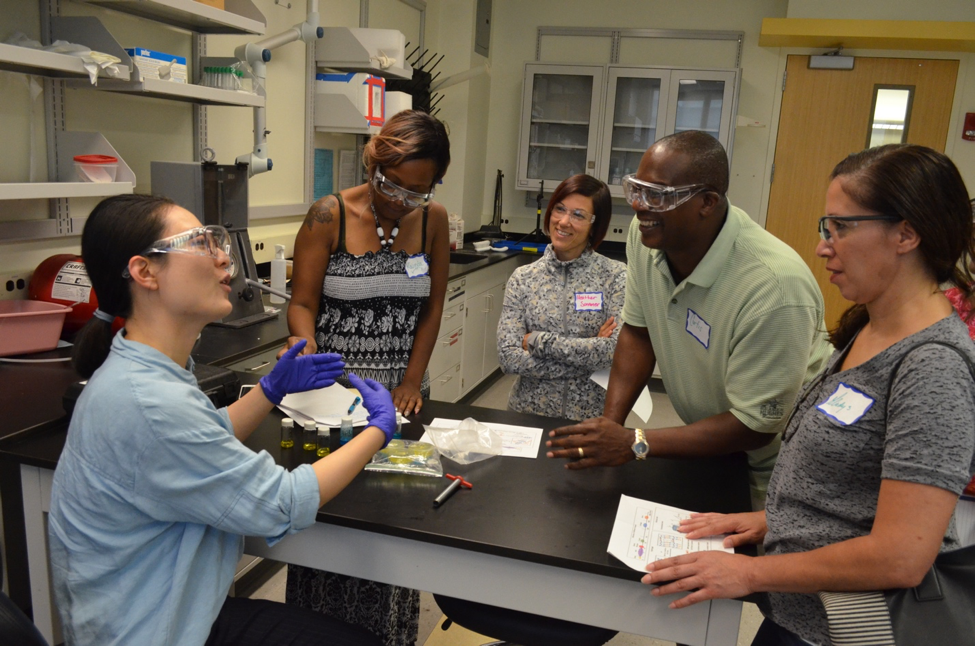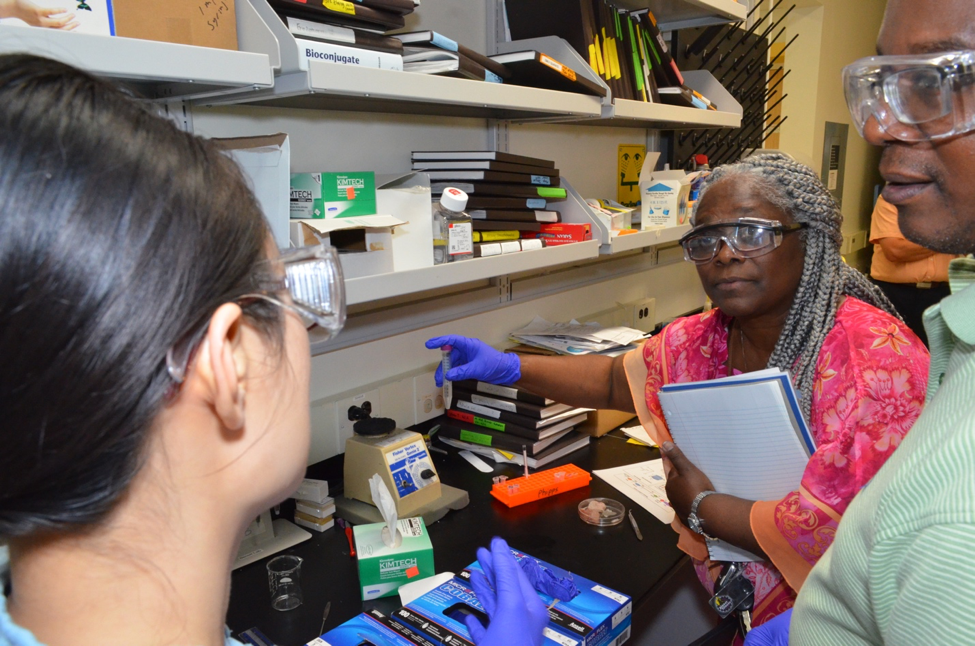Benoit lab helps teachers inspire the next generation of researchers

It was “all hands on deck” in the Benoit lab recently when Rochester City School District elementary teachers spent a day learning how hydrogels and other biomaterials can be used for tissue repair and targeted drug delivery.
Their visit was part of a Warner School program to help prepare public school educators for new state-mandated standards they’ll be expected implement in their science and math classes.
And the Benoit lab members were more than happy to help.
“We have a good time talking to teachers because they’re the ones in the field, doing the real-life work of educating the next generation, which is really awesome,” said lab technician Azmeer Sharipol, who welcomed the teachers and gave them an overview of the lab’s work.
Four postdocs, five PhD students, two laboratory technicians, an undergraduate student, and Professor Benoit then pitched in to present four lab demonstrations on how:
- the lab adjusts the stiffness of hydrogels to precisely mimic the environment that different types of tissue cells need to survive.
- RGD peptides can be used to attach cells to hydrogels.
- Materials with hydrophilic and hydrophobic regions can form nanoparticles for drug delivery.
- tissue arrays grown in microbubbles can speed up the testing of therapeutic drugs.
Clearly, these are not topics an elementary teacher would need to know as part of a typical second-grade lesson plan. But that was precisely the point, says Marie Rice, a city school district teacher who helped facilitate the visit.
“As adults, we’re used to being the person who knows everything, especially when we’re working with our students,” says Rice, who is also a Noyce Master Teacher Fellow at the Warner School. “So, one of the great things about this set of workshops is that it puts our teachers back in the role of a learner, so they can experience what it’s like from a student’s perspective.”
That way the teachers can better appreciate the importance of observing, asking questions and seeking clarification—three of the competencies they will need their students to master.
The program was designed so the teachers would receive only a basic introduction to the topics before going into the labs for the actual demonstrations.
“If we start off by teaching you everything that you need to know, and then take you into the lab, there’s nothing left to learn. So, what we’re doing is flipping that,” Rice says. “We’re giving you just enough to survive, and then throw you into a lab where you actually have to start making sense of it yourself. That way the ownership of the learning is yours.”
However, lab members also suggested experiments the teachers could use in their classrooms to illustrate basic scientific concepts that underly much of their research.
For example, postdoctoral fellow Yiming Li showed the teachers how to do a “tube inversion test” – an experiment to evaluate the relative viscosity of gels. “This experiment can be done in classrooms where student can make gels using different ratios of JELLO powder and water,” Li explained.
The teachers were also interested in the daily log postdoctoral fellow Ken Sims kept while doing experiments to develop a drug-delivery system targeting dental plaque. Sims kept detailed notes, including diagrams and mathematical calculations.
“Our kids are supposed to maintain lab books too, but a lot of teachers don’t know what the lab books should actually contain,” Rice said. “What’s the standard of practice? So now we’re walking away with a unified sense of what they’re logs should contain, to adequately prepare them for doing science in the future.”
Even a Fisher Vortex Genie-2 device in one of the labs -- used to quickly mix materials in a test tube -- caught the eye of Cassandra Dearring, a 6th grade teacher at Wilson Foundation Academy.
“Kids would love using that, and it would start giving them a sense of the kinds of tools that scientists use to do their research, at a young age,” she said. “I liked everything we were learning this morning. And as I was listening and learning, I was wondering how I can apply it and connect it with the children in my classes?”
That’s why Li and the other students don’t mind pitching in. “I think the ‘teach the teachers’ program is very valuable and beneficial for us, the teachers and their students,” Li says. “This activity can definitely make broader impact by sharing our scientific research and ideas with the people outside the scientific fields, in a relatively easy and understandable way. Additionally, teachers and students can learn what kinds of cutting-edge research and advanced science are going on in labs, which can potentially raise students’ interests and passion for science. This can be a way to cultivate the next generation of scientists.”

Cassandra Dearring, a 6th grade teacher at Wilson Foundation Academy, uses a Fisher
Vortex Genie-2 device to quickly mix materials in a test tube.
